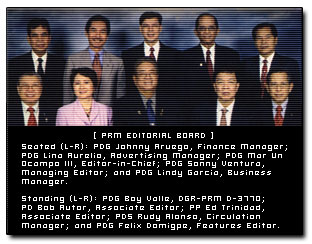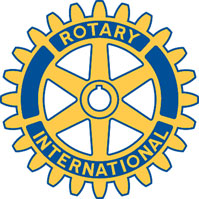

Everything You need to know about Rotary and PRM:
| About the Philippine Rotary Magazine | |
| About the PCRG | |
| About ROTARY | |
| Rotary Mission and Functioning Club | |
| A One Page History of Rotary |

About the Philippine Rotary Magazine
The Philippine Rotary is a magazine published monthly by the Philippine College of Rotary Governors (PCRG). It is the official regional magazine for Philippine Rotary Clubs authorized by Rotary International. It contains articles and features about Rotary in the Philippines and around the world. Guided by the editorial policies of Rotary International, it contains articles found in the current issues of The Rotarian, Rotary International’s official publication for all Rotarians worldwide, and articles and features of local (Philippine) interest.
[top]
About the PCRG
The Philippine College of Rotary Governors (PCRG) is an association of past, present and incoming Districts Governors, whose purpose is to promote close coordination and camaraderie among the ten Rotary Districts in the Philippines with the common goal of supporting the various programs, policies and objectives of Rotary International in the spirit of fellowship.
[top]
 About ROTARY
About ROTARYRotary is a worldwide organization of men and women in profession and business dedicated in providing service to their fellowmen in the spirit of fellowship. Rotary was founded in 1905 by a lawyer, Paul P. Harris, who thought of organizing together a group of business friends representing a different trade or profession each, for friendship and service. Thus, he invited a coal dealer, a mining engineer, a printer, a merchant tailor and a marble trader to form a club which they later called “Rotary”, since the plan was to meet “in rotation” at each other’s offices. Rotary has grown dramatically over the years and as of December 31, 2003 there were 1,211,723 Rotarians, 31,603 Rotary Clubs and 529 Districts in 166 countries. Rotary’s motto is “Service Above Self”, which embodies its commitment of unselfish devotion to service. Rotary classifies its service into the “four avenues of service”, namely: Club Service, Community Service, Vocational Service and International Service. It has also opened another “avenue of service”, the Youth Service or New Generations, to recognize the importance of providing guidance to future leaders and Rotarians.
[top]
Rotary Mission and Functioning Club
The Board amended the mission of Rotary International to read as follows:
The mission of Rotary International is to support its member clubs in fulfilling the Object of Rotary by:
| Fostering unity among member clubs; | |
| Strengthening and expanding Rotary around the world; | |
| Communicating worldwide the work of Rotary; and | |
| Providing a system of international administration. |
The Board approved an implementation plan designed by the General Secretary to restructure the operations of the current RI Service Centers so that their organizational structures and business processes are cost effective and consistent with RI World Headquarters.
The Rotary Code of Policies will now be published on the RI web site and updated after each Board meeting. An annual edition of the Code will be prepared in compact disk form to be available gratis to each Trustee, Past Director, Governor and Governor-elect upon request. The CD form will also be offered as a sale item to any other interested Rotarian or club.
RI policy allows the RI Board to terminate the membership of any club under RI bylaws 3.030.2. for "failure to function." The Board defines a functioning club as| maintaining at least 20 club members, the number of members required when chartering a new club; | |
| having paid its per capita dues to Rotary International; | |
| meeting regularly; | |
| ensuring that its members subscribe to The Rotarian or an approved regional magazine; | |
| implementing service projects that address needs in the local community and/or in communities in other countries. |
A One Page History of Rotary
In 1905, 37 year old attorney Paul Harris changed the world.
Paul Harris, who was raised by his New England grandparents with values of tolerance toward all, gained his law degree in 1891. 1In his senior year, a former graduate told his class that they should “Go to a small town for five years make a fool of themselves, then go to the big city!” Paul decided to hit the road for the entire world. He worked as a reporter for the San Francisco Chronicle, 1891; manual laborer on a fruit ranch, then raisin packing plant, teacher at the L.A. Business College in 1892. Denver, Colorado, 1892: Actor in a stock company, reporter for the Rocky Mountain News, cowboy, reporter for The Republican. Jacksonville, Florida: St. James Hotel night clerk, traveling granite/marble salesman 1892/93, reporter on the Washington Star, cattleman on a ship 1893, haymaker and cannery worker 1893, sub-foreman of the gang of cattlemen 1893, (where he wrote that, on his first voyage, he experienced sub-human conditions); orange picker in Florida 1893, back to Jacksonville selling marble granite. His territory included the southern states, Cuba, the Bahamas and Europe. When he announced that he was going to Chicago to practice law his employer said, "Whatever the advantages of settling in Chicago may be, I am satisfied you will make more money if you remain with me." To which Paul replied: "I am sure you are right but I am not going to Chicago for the purpose of making money; I am going to the purpose of living a life."
 In 1896, he did go to Chicago to practice law. One evening, in the early 1900’s, Paul went with a professional friend to his suburban home. After dinner, as they strolled through the neighborhood, Paul’s friend introduced him to tradesmen in their stores. This reminded Paul of his grandparent’s home in New England. “Why not have a fellowship composed of businessmen from different occupations, without restrictions of politics or religion?” he thought.
In 1896, he did go to Chicago to practice law. One evening, in the early 1900’s, Paul went with a professional friend to his suburban home. After dinner, as they strolled through the neighborhood, Paul’s friend introduced him to tradesmen in their stores. This reminded Paul of his grandparent’s home in New England. “Why not have a fellowship composed of businessmen from different occupations, without restrictions of politics or religion?” he thought.
Who was the first Rotary president? Silvester Schiele. When it came time for the meeting to be held at A. L. White's place of business (at Englewood), the location was “inconvenient” and thus was the first Rotary meeting in hotel. As with many new ventures, some new members didn’t remain. Shorey and Loehr, half of the original four were not active after the first few meetings. When did weekly meetings begin? 6According to the general secretary in 1948, it was Oakland #3 in 1909.
Paul was very interested in starting Rotary in other cities. The second Rotary club was founded by Homer Wood in San Francisco in 1908. 7Wood then quickly organized Oakland #3, Seattle #4 and Los Angeles #5. In fact, before the end of 1909, there were seven clubs, including New York City #6 and Boston #7. That's right, in 1908 and 1909, Homer Wood started four clubs. In the rest of the United States there were two, and the San Francisco club is credited, by some, with starting New York.
The activity caused by San Francisco created the first major conflict within the Rotary Club of Chicago. Too much of the meeting time was being taken up with reports of "new clubs." Harris also had a vision of “Around the World Rotary” which was also opposed by many of his fellow Rotarians. It was not until he won the loyalty of the man who was to be Rotary’s secretary from 1910 – 1942 that Rotary became organized and international. That man was Chesley Perry, whom Paul called the “Builder of Rotary.”By August 1910 there were sixteen clubs and the National Association of Rotary Clubs was organized and held its first convention that year, in Chicago. At the 1911 Portland Convention, “Service, Not Self” was introduced by Frank Collins of Minneapolis. It later became “Service Above Self.” The slogan “He profits most who serves best,” was also read there. It had been written by Arthur Sheldon and delivered by him at the first convention the previous year in Chicago. Both were approved by RI in 1950. Learn what Sheldon really meant by his well thought phrase. You can study all of Rotary's conventions from 1910 on and learn about each of our presidents from Paul Harris to the present as well as their clubs from our web site dedicated to presidents of Rotary.
Another important event at the 1911 Portland convention was the platform brought forward by Seattle #4. This platform, is still essential to the philosophy of Rotary today.
When clubs were formed in Canada and Great Britain in 1912, the name was changed to the International Association of Rotary Clubs, and was later shortened to Rotary International in 1922. 5Paul Harris was the first president of the National Association of Rotary Clubs, serving two terms. He was named President Emeritus of the International Association in 1912 and served until his death in 1947. 1Harris suffered a near fatal heart attack in his final year as president of the National Association and required a full year to recover. Yet, over the next 35 years, he and his wife Jean Thomson Harris made numerous exhausting trips to nearly every continent, visiting hundreds of cities, planting friendship trees and attending Rotary conferences.As Rotary spanned the globe, branch offices were opened in Europe, South America, South Asia, Southwest Pacific. In the UK British Rotary had its own office. 6When Rotary International President Emeritus, world traveler, author and prominent Chicago attorney Paul Harris passed away on January 27, 1947, his dream had grown from one group of four to 6,000 clubs in 75 countries with 300,000 members brought together through the service and fellowship of Rotary
the UK British Rotary had its own office. 6When Rotary International President Emeritus, world traveler, author and prominent Chicago attorney Paul Harris passed away on January 27, 1947, his dream had grown from one group of four to 6,000 clubs in 75 countries with 300,000 members brought together through the service and fellowship of Rotary
There are over 31,000 Rotary clubs, in 164 countries, whose members carry on club, vocational, community and international service. The Rotary Foundation of Rotary International annually spends some $105 million on international education and humanitarian programs, providing grants which save lives and improve conditions throughout the world. Rotary also sponsors international ambassadors of good will through educational awards to university students and teachers, and through international exchange of business and professional people. Today
the Rotary Foundation scholarship program is the world’s largest privately funded international scholarship program.
Approximately 1,100 scholarships are awarded annually. Rotarians have raised some 438 million dollars for the
PolioPlus program alone as well as provided thousands of volunteers to administer the vaccine around the world.
[top]